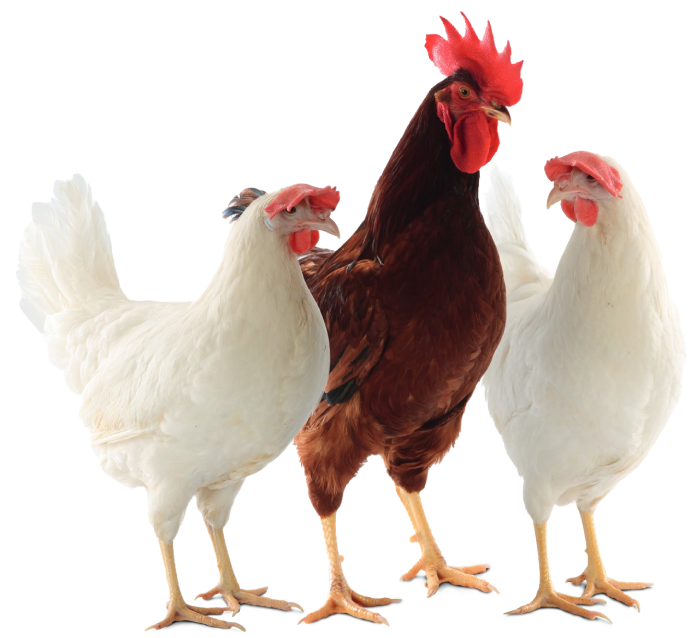Summary
Rearing pullets in deep litter and perchery systems requires more time, effort and expertise. The flock
has to be continuously monitored to ensure optimum growth. The foundation for the hens’ performance in the subsequent production phase is established during the growing period. Rearing should
therefore be regarded as an investment phase. It cannot be managed from an office desk. Constant
monitoring and observation of the flock are the key to success.
Introduction
The productivity of laying hens has been improved enormously in the last 20 years as a result of selective breeding. Modern hybrids mature very early and are characterised by top performance, very good liveability with almost consistently high egg quality and excellent feed conversion efficiency.But this genetic improvement in productivity imposes increased demands on the management of modern layer hybrids. The key to success is to achieve a 17- to 18-week pullet rearing period. While the rearing of caged pullets to egg-laying maturity is still fairly straightforward despite increased demands, preparing pullets for conventional deep litter and perchery systems, perhaps with access to a winter garden and paddock, or for free-range systems requires more technical expertise.
The following chapter therefore focuses on the rearing of young pullets and their preparation for deep litter and perchery housing systems.
Pullets destined for alternative housing systems should also be reared in deep litter and perchery systems. The more closely the growing facility resembles the future production system, the easier it will be for the pullets to settle down in their new environment after transfer to the laying house.
Deep litter system
Floor rearing systems for chicks and pullets should consist of a well littered, climate-controlled, illuminated shed which, as well as feeders and drinkers, also provides slightly raised roosting places. Chicks learn and want to fly up to rails or perches at an early age. If perching or flying is learnt too late it can result in reduced mobility of individual hens in the future laying house. Rails or perches should therefore be available to chicks before the age 6 weeks.Mounting feeders and drinkers on or alongside the perches is a very effective preparation for the production phase. Floor rearing systems with a droppings pit on to which feeders and drinkers are mounted are particularly effective for familiarising the birds with the design of the laying house.
Perchery system
Percheries can accommodate more birds per m² of floor area than deep litter systems because the total amount of usable space is greater. Multi-tiered perchery systems of different designs are currently offered by several manufacturers, with appropriate management recommendations.The levels are furnished with plastic or wooden slats and feature manure belt ventilation. Feeding and watering facilities are usually located only on the bottom and middle levels. The top level is used by the pullets at night as a roosting area. This natural behaviour can be reinforced by using the lighting system to simulate sunset. This involves turning off the light in a step-wise sequence, starting with the bottom and middle levels and finally the top level.
In the morning the birds should go to the two lower levels for feeding. By moving between the resting zone and the other levels the pullets get physical exercise and familiarise themselves with the perchery environment. Staggered feeding on the lower tiers promotes flexibility of movement.
Litter
The type and quality of the litter are especially important for young chicks. Straw must be clean and free of mould. Wheat straw is preferable to barley or oat straw. Barley straw contains awn residues which can cause injury to chicks, and oat straw does not absorb sufficient moisture. To reduce dust formation the straw should not be chopped but should be put down as long straw. Splicing improves moisture absorbency. Long straw has the added advantage of encouraging the chicks to forage. This stimulates the birds‘ natural investigative and feeding behaviours, thus reducing the risk of feather pecking. Wood shavings are good litter material provided they are dust-free and come from softwood varieties that have not been chemically treated; minimum particle sizes of $ 1 cm are recommended. Chicks must on no account ingest fine particles as these, when combined with water, swell up in the oesophagus, causing ill health and reduced feed intake.Litter should be put down after heating the shed, when the floor has reached the correct temperature. Significant differences between floor and room temperature when litter is spread too soon change the dew point. The litter becomes wet from below and sticky.
House climate
Desired temperatures at bird level at a relative humidity of at least 40 – 45 %:Temperature when birds are placed 34° C
Then day 1 – 2 34 – 32° C
day 3 – 4 31° C
day 5 – 7 30° C
2nd week 29 – 28° C
3rd week 27 – 26° C
4th week 24 – 22° C
5th week 20 – 18° C
6th week 18 – 20° C
Scientific studies show that the optimal body temperature is 40 to 41° C. If this is measured with suitable thermometers house temperatures can be adjusted accordingly.
Chicks from young parent flocks require a 1° C higher temperature on arrival.
The heating should be turned on as soon as the exterior temperature drops to ensure that the recommended temperatures are maintained at bird level. A uniform house climate can be maintained by proper regulation of the heating and ventilation facilities. The chicks‘ behaviour gives clues to proper climate management:
- The chicks are dispersed evenly and move around freely => temperature and ventilation are just right
- The chicks huddle together or avoid certain parts of the building => temperature too low or draughts
- The chicks are prostrate with wings spread out and gasping for air => temperature is too high
When controlling the temperature by ventilation it is important to ensure that sufficient fresh air is provided. The following minimum requirements for house air should be maintained:
O2 over 16 %
CO2 under 0.3 %
CO under 40 ppm
NH3 under 20 ppm
H2S under 5 ppm
Placement of chicks – deep litter system
It is advisable to place the chicks close to the watering and feeding facilities in the building. If an even temperature distribution within the house cannot be guaranteed or if radiant heaters are used, the use of chick guards or similar devices for keeping the chicks together has proved effective. These restrict the chicks to those areas of the building where the climate is optimal and where feeders and drinkers are located.The shed can also be furnished with chick feeding bowls to ensure a better feed intake in the first few days. Both standard feeders and these additional chick bowls should be filled with a layer of about 1 cm of coarse starter feed. As soon as the chicks are able to eat from standard feeders the bowls should be gradually removed.
If radiant heaters are used chick guards or similar devices for keeping the chicks in the warm area should be installed underneath. This provides a draught-free and comfortable microclimate for the chicks during the first two to three days after hatching.
If the chicks are housed in sheds equipped with dropping pits it is advisable to place narrow strips of thin, corrugated cardboard over the slats (40 – 50 cm wide) on which drinkers, feeding lines and the chick bowls used for the first week are placed. Chick guards or similar devices are again very useful for keeping the chicks close to water, feed and heat sources during the first few days of life.
Placement of chicks – perchery
Depending on the system, the chicks are placed either on the middle or bottom level of the perchery where they remain up to about day 14/21. Feed and water are close by so that the birds become fully accustomed to their environment. From 3 to 4 weeks of age the „training tiers“ are opened. Now the birds can move freely throughout the building and learn to jump and fly. Percheries which provide feed and water on all tiers and can be operated similar to a battery system by confining the chicks during their first few weeks of life may be very convenient for the pullet producer but are less suitable for training the chicks to move around the system. In these systems, too, the tiers should be opened as early as possible and chick movement within the house stimulated by staggered feeding on the different tiers. Here, too, it is essential that take-off, landing and flying should be mastered by 6 weeks of age. During the first few days of having access to all parts of the house the chicks should be closely watched. Disorientated birds have to be moved manually and trained by the attendants.Pullets which will later be moved to production percheries where they have to fly onto perches for feeding should preferably be familiarised with this type of perch while still in the growing facility. The pullets should be moved to the laying house well before the proposed start of production. They are then better able to find their way around the different areas (feeding, scratching, roosting). By eliminating stress during the period of adaptation to perchery systems, existing nest boxes are more readily accepted and the daily feed intake is more likely to keep up with the birds‘ growing requirement at the onset of production.
Rough estimates of the equipment needed for deep litter/perchery systems are as follows:
Equipment needed for rearing

Intermittent lighting programme for chicks
Young chicks arriving at the rearing farm have already endured a long transport after hatching. The general practice is to provide 24-hour light for the first two to three days after arrival to give the chicks time to recover and eat and drink ad libitum.But in reality it has been observed that some chicks continue to rest after arrival while others seek out food or water. Flock activity will therefore always be uneven. During this phase of rearing attendants find it particularly difficult to accurately assess chick behaviour and condition.
An intermittent lighting programme, specially designed for this period and tested in practice, divides the day into resting and activity phases. The objective of such a programme is to synchronise chick activity in order to make it easier for the staff to assess the condition of the flock more accurately and to stimulate food and water intake through group behaviour.
It is recommended to allow the chicks a brief period of rest on arrival at the rearing farm and then start the intermittent lighting programme of 4 hours light followed by two hours dark. Lighting programme for chicks during the first 10 days of life:
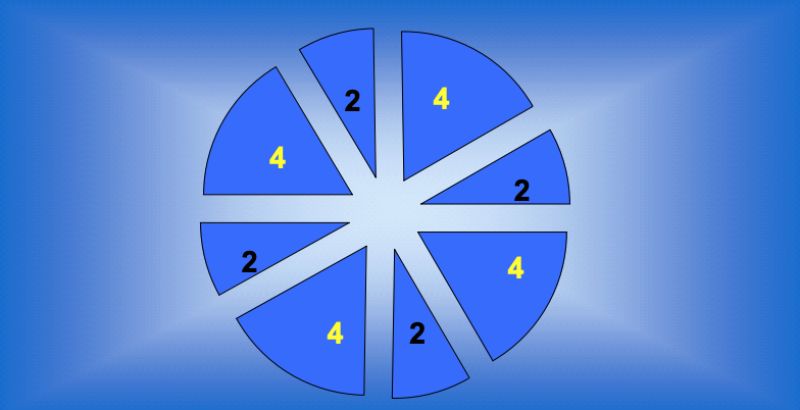
This programme can be applied up to day 7 or day 10 post arrival, followed by a switch to the regular programme with a reduction of the day length. The benefits of using this programme are:
- Chicks rest or sleep at the same time. Chick behaviour is synchronised.
- Weak chicks are stimulated by stronger ones to be active and ingest feed and water.
- Flock behaviour is more uniform, making chick assessment easier.
- Losses in the first week are reduced.
Stocking density
The stocking density depends on the housing system. In deep litter systems stocking densities of up to 15 birds/m² of usable floor space are acceptable.Perchery stocking rates should follow the recommendations of the manufacturer of the system concerned. Densities of up to 30 pullets / m² of usable room space are possible.
These stocking densities are only realistic, however, if the provision of feeding and watering systems complies with the regulations for technical equipment.
Grit
The provision of insoluble grit for free access feeding from circular troughs is recommended. This stimulates the development of crop and gizzard, which in turn has a positive effect on feed intake capacity.The following are reference values for the granulation and amount of grit to be supplied:
1 – 2 weeks of age: Once weekly 1 g/bird (1 – 2 mm granulation)
3 – 8 weeks of age: Once weekly 2 g/bird (3 – 4 mm granulation)
From 9 weeks of age: Once a month 3 g/bird (4 – 6 mm granulation)
Beak treatment
Birds reared on the floor and in percheries can roam freely around the barn. These housing systems do not promote the formation of stable social structures like those found in smaller flocks. Recent scientific studies have shown that when hens who do not know each other first meet in the barn they explore their flock mates by pecking. This behaviour, referred to as exploratory pecking, forms part of the natural repertoire of fowls.Situations such as high dust levels, poor house climate, at times very high stocking densities in selected areas of the poultry house, reaction to vaccinations and other disruptive factors which, despite best efforts, cannot always be avoided in floor and perchery systems, lead to a state of frustration in hens. Aggressive feather pecking, which occurs as a consequence of such stress situations, has also been shown to be a natural reaction by hens.
Beak treatment is recommended for hens in deep litter systems and percheries in order to limit the adverse effects of both types of feather pecking and to minimize the risk of cannibalism.
The EU directive on the management of laying hens (Council Regulation 1804/1999 of 19.07.99) provides that treatment of the beak tips may be carried out up to the age of 10 days. In Germany beak treatment is subject to authorisation by a government veterinary officer.
As beak treatment is stressful for the chicks they must be conditioned for the procedure. A vitamin supplement of the A, D3, E and K3 groups on the day before, a 6-8-hour fast prior to the procedure and raising the room temperature by 1° C at the time of the beak treatment procedure are recommended to ensure that the birds recover quickly from this operation.
Subject to national regulations, beak treatment must be performed with utmost care! A poorly treated flock grows unevenly, resulting in lack of uniformity at the end of rearing.
Nutrition
Because of their higher activity levels, pullets kept on the floor or in percheries require more feed of the same nutrient density than caged birds. In addition to the lighting programme and adequate body weight development, nutrition is the third key factor in reaching laying maturity. When formulating diets for pullets the nutrient requirements specified by the breeder for the product concerned should be taken into consideration.Compound feed manufacturers offer a four-phase feeding programme for this purpose (chick starter, chick grower, pullet feed, pre-lay ration):
Example of a commercially tested starter and grower feeding programme:

The indicator for switching from one diet to the next is the hens’ body weight development. The correct time for changing the diet is determined not by age but by body weight. It is therefore essential to weigh chicks and pullets at regular intervals. In-feed coccidiostats should be used only if no coccidiosis vaccination is carried out. Vaccinated hens must on no account be given coccidiostats via the feed.
Chick meal should be homogeneous and have sufficient structure. Too high a proportion of very fine constituents or a structure that is too coarse lead to selective feeding and an uneven nutrient intake. The meal should not contain whole cereal grains. Excessively fine feed reduces the birds’ feed intake, leading to an undersupply of individual nutrients.
For pullets in deep litter or perchery systems who will be housed in equivalent systems after rearing the provision of a pre-lay diet is highly recommended. The pre-lay diet has approximately twice the calcium content of pullet feed and higher levels of protein and amino acids. Feeding such a diet for about 14 days prior to the proposed onset of lay is beneficial, and essential if chicks are moved to the laying house early. This diet improves flock uniformity by enabling early maturing birds to obtain sufficient calcium for eggshell production and by providing a better nutrient supply for late maturing birds.
The foundation for ensuring a sufficient intake of the feed offered, especially after moving the pullets to the production facility, should be established during the growing phase. This is achieved by feeding a ration with a lower protein density, good structure and a slightly higher crude fibre content. The pullets should learn at an early age to empty the feeders preferably once a day, but at least several times a week. A balanced intake of coarse and fine feed constituents and an improved appetite to the next feeding increase feed intake. The ability to consume large amounts of feed learnt during this phase will be crucial to the pullets after moving to the laying house, when feed intake has to increase sharply.
Uniformity
The uniformity of a flock is an important measure of the quality of rearing. It states in mathematical terms how many of the birds weighed in a sample are within a range of ± 10 % of the measured mean body weight of the sample. It is determined in 1 % of the flock by weighing individual birds. Uniformity is an indicator of the expected production level of the flock during the laying period. Uniformity is affected by factors such as:- Chick quality
- Stocking density
- Feeding
- Lighting programme
- Vaccinations
- Diseases Healthy flocks reared in accordance with breeders’ recommendations are very uniform.
Lighting programmes
Sexual maturity and laying performance are materially affected by the lighting programme to which the hens are exposed during the growing and production phase. In systems where pullets are kept in windowless housing without access to the outdoors lighting programmes can be designed in such a way that optimal rearing and preparation for the laying period are guaranteed. After placement of the chicks the day length is gradually reduced. Then, after a phase of constant day length, light hours are stepped up again in order to stimulate egg laying activity. The lighting programme shown in the graph below can be varied depending on the breeder’s recommendations and the desired production level of the flock. As a general rule, the day length should not be increased during the growing phase up to point of stimulation for egg-laying and should not be decreased during the production phase.Example of a lighting programme for windowless poultry houses:
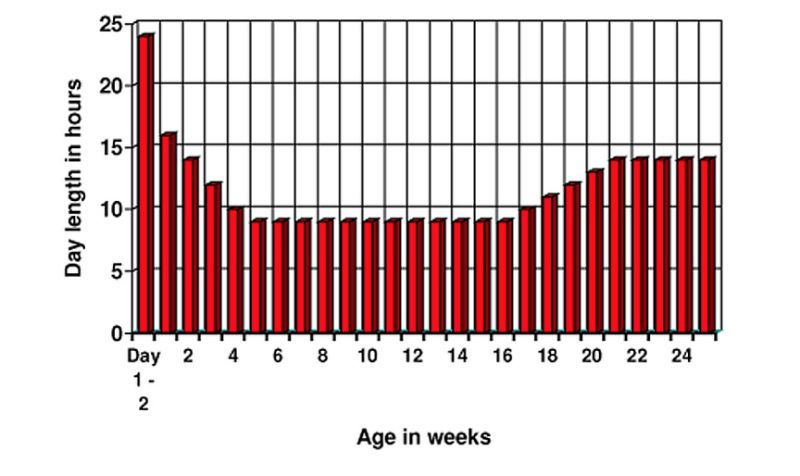
So as not to violate this basic rule, it is recommended that houses with natural daylight entering through windows or other openings should be blacked out, especially for chicks hatched during months with increasing daylight.
Without restricting the natural day length, flocks in central European latitudes would grow into lengthening days from March to June. This would result in a premature onset of lay and subsequent underperformance. It would also be difficult to design an optimal lighting programme for flocks reared from July to September. In houses where windows or light openings cannot be blacked out a lighting programme as described in the graph for windowless houses, which proposes a temporary restriction of the day length to 8 or 9 hours, is only viable during the autumn and winter months. Windows or openings through which natural daylight enters should therefore have a black-out facility. The times for darkening the room or opening the windows should be synchronised with the lighting programme. It is important to follow the correct sequence: in the evening close the windows first, then switch off the light; in the morning switch on the light first, then open the windows. This procedure should be continued after transfer to the production facility until the maximum day length in accordance with the chosen lighting programme is reached. This avoids unnecessary stress for the hens caused by an abrupt lengthening of the light day after moving into accommodation with windows; 17 hours of daylight is the norm in June. It is also important to ensure that the artificial lighting programme and the natural light day do not conflict.
Vaccination programme
Vaccinations are preventative measures against infectious diseases and help to keep flocks healthy and productive. The success of vaccinations is essentially determined by the following factors:1. Selection of suitable vaccines
2. Selection of appropriate vaccination times
3. Selection of suitable vaccination methods
4. Eligibility of birds for vaccination
Vaccines are veterinary medicinal products that are available on prescription from the veterinarian attending your flock. The manufacturer’s directions for use must be observed. In Germany vaccinations of laying hens against Salmonella and Newcastle Disease are mandatory under law.
Depending on the region, hens kept in alternative systems should also be vaccinated against fowlpox and, especially in the case of free-range hens, against EDS (Egg Drop Syndrome) as wild waterfowl are a reservoir of EDS virus. A combined vaccination against IB, ND, EDS and sometimes also ART is often carried out.
Regular blood tests to monitor the success of vaccination measures are recommended.
The most common vaccinations are:
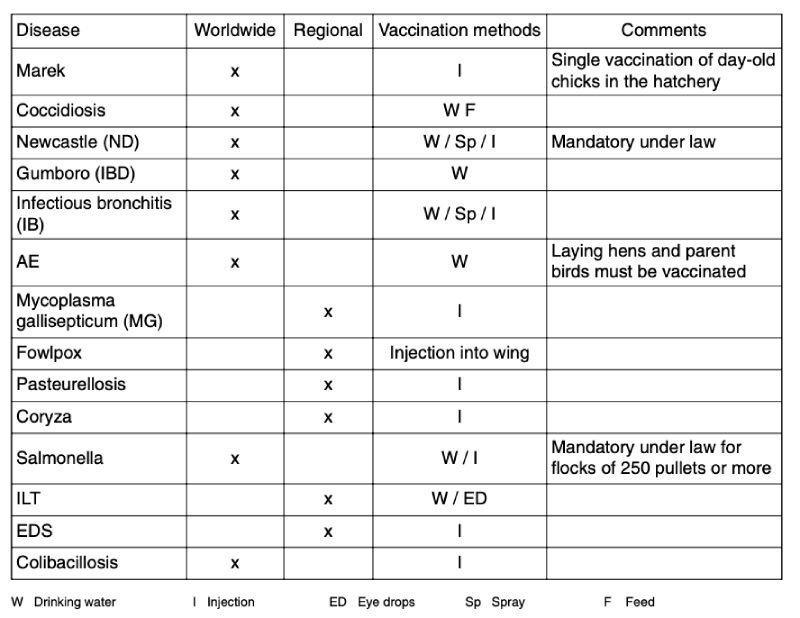
Supplementary vaccinations
The infection pressure in deep litter systems is far greater than for caged birds. Moreover, strains of coliform bacteria and Pasteurella can occur and develop in a very narrow geographical area. In such cases it may be necessary to design highly specific vaccines for use in the rearing facility.Vices
Watch birds closely for any signs of abnormal behaviour such as feather pecking or cannibalism. A sudden outbreak without having changed the lighting regime can have a variety of reasons. If these vices occur, check the following:- Nutritional and health status of the flock – body weight, uniformity, signs of disease.
- NStocking density – overcrowding or insufficient feeders and drinkers cause anxiety in the flock.
- NHouse climate – temperature, humidity, air exchange rate or pollution by dust and/or harmful gases.
- NLight intensity / light source – excessive light intensity, flickering light (fluorescent tubes or energysaving bulbs emitting light at too low a frequency) or light outside the red spectrum cause distress to the birds.
- NEcto- and endoparasites – infested birds are restless and develop diarrhoea.
- NFeed consistency – do not feed very finely ground meal-type rations or pelleted feed. Both encourage abnormal behaviour.
- NAmino acid content of the ration – deficiencies of sulphur-containing amino acids cause problems.
- NSupply of calcium and sodium – deficiency makes the birds irritable
Molting
Growing pullets change their plumage several times. The growing chick replaces the down of the day-old with the first full feather coat. This process is largely completed at 5 weeks of age. The birds‘ growth slows down during moulting.At 8 to 9 weeks old a further slight but incomplete moult takes place. At that age more feathers than usual can be found in the litter of floor-reared or perchery hens.
An intensive and complete change of plumage is observed from 13/14 weeks of age. This moult also involves successively changing the flight feathers. At 15 weeks numerous feathers are found on the floor of the poultry house of a well developed flock. The absence of molting at 13 weeks indicates poor weight development or lack of flock uniformity; bodyweight and uniformity should then be determined as a matter of urgency. If the flock is found to be underweight it is advisable to check for viral or bacterial infections (coccidiosis is a common cause of growth depressions) and to examine whether the feed quality is satisfactory.
If necessary, the ration should be changed temporarily by feeding chick grower instead of pullet feed in order to remedy the developmental deficit as quickly as possible.
Only when the final moult is almost complete (normally at 14/15 weeks of age) are light intensity and length of illumination increased in readiness for the impending start of lay. Practical experience has shown that this is the best time for moving the birds to the layer house.
Wings of a pullet aged about 18 weeks:

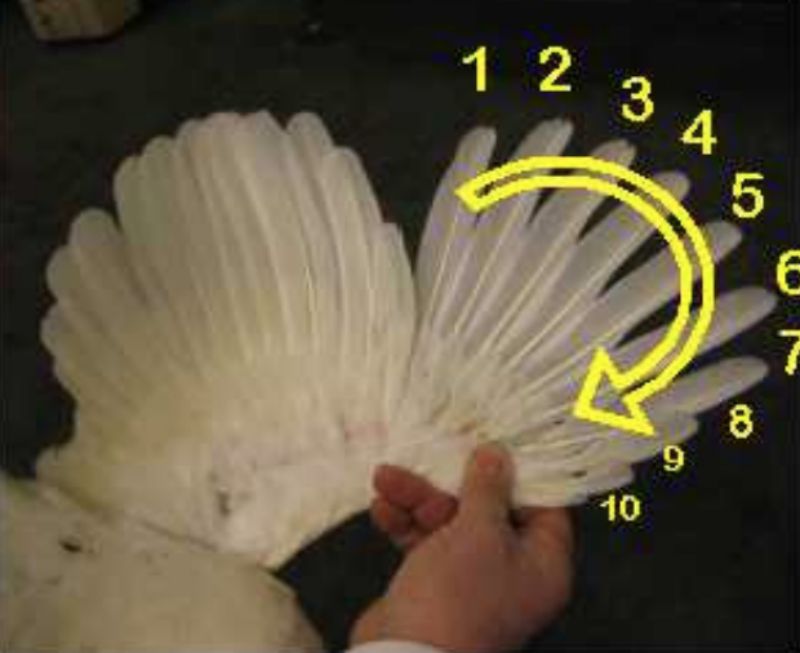
Moving to the laying house
The move from the growing facility to the laying house should be done gently but quickly. Catching and transporting is stressful for the birds. They also have to adapt to a strange environment. A stressfree transfer and careful acclimatisation of the flock to the new management system are crucial and ensure good production results.It is advisable for pullets from alternative rearing systems to be moved in good time before the proposed onset of lay. This ensures that the pullets become familiar with their new surroundings before they start laying.
It is normal for pullets to lose weight after transport and rehousing. It is therefore important that the birds are quickly able to locate feed and water to ensure a sufficient food intake. Effective ways of encouraging pullets to eat include moistening the feed, running the feeding lines more frequently, the use of skim milk powder or whey fat concentrate and vitamin supplements.
Pullets must on no account lose weight after rehousing. They should continue to gain weight, or at least maintain their body weight. If the housing system permits it and provided stocking densities are not exceeded by doing so, the pullets should be confined to the grid above the dropping pit or in the perchery until they have reached approximately 75 % production.
Partially closing the scratching area (leaving the birds a minimum amount of space) and manually moving disorientated birds back into the system have also proved effective.
Zusammenfassung
Managementempfehlungen zur Junghennenaufzucht für Bodenhaltungs- und VolierensystemeDie Aufzucht legereifer Junghennen ist als eine Investitionsphase für Legehennen zu betrachten. Bei der Aufzucht für Boden- und Volierensysteme, u.U. mit Wintergarten und Freilandauslauf oder für Bio-Haltung, ist besondere Sachkenntnis erforderlich, die durch innerbetriebliche Erfahrung weiterentwickelt werden sollte. Tägliche Beobachtung im Stall ist erforderlich und nicht durch Planung im Büro zu ersetzen. Insbesondere zu beachten ist: • Junghennen für alle nicht-Käfigsysteme sind grundsätzlich in Boden- und Volierensystemen aufzuziehen. Je ähnlicher der Aufzuchtstall dem späteren Produktionsstall gestaltet ist, umso unproblematischer wird die Umgewöhnung.
• Die Küken sollten frühzeitig – möglichst vor der 6. Lebenswoche – lernen, auf Reuter oder Sitzstangen aufzufliegen. Volieren sollten frühzeitig geöffnet werden.
• Die optimale Besatzdichte hängt vom jeweiligen Aufzuchtsystem ab; angemessene Ausstattung mit Futter- und Tränksystemen ist dabei zu beachten.
• Um Federpicken zu begrenzen und Kannibalismus möglichst zu vermeiden, ist das Behandeln der Schnäbel zu empfehlen.
• Wegen höherer Bewegungsaktivität benötigen Junghennen in Boden- oder Volierenhaltung von einem Futter vergleichberer Nährstoffdichte größere Mengen.
• Der Futterwechsel (Küken-Starter, Küken-, Junghennen- und Vorlegefutter) richtet sich nicht nach dem Alter, sondern nach der Gewichtsentwicklung der Tiere. Management Recommendations for Rearing Pullets for Alternative Housing Systems Vol. 42 (2), Oct. 2007, Page 24
• Eine ausreichende Futteraufnahme bei Legebeginn ist durch die Verfütterung eines Junghennenfutters mit geringem Protein- und hohem Rohfasergehalt zu erreichen.
• Das Lichtprogramm ist so zu gestalten, dass die Länge des Lichttages während der Aufzucht nicht zunimmt und während der Produktionsphase nicht abnimmt.
• Bei Kunstlicht aufgezogene und in Ställe mit Tageslicht umgestallte Hennen müssen sich an die veränderte Umwelt allmählich anpassen. Fenster sollten in den ersten Wochen nach der Umstallung verdunkelt werden.
• In Bodenaufzuchten ist der Infektionsdruck vielfach höher als in Käfigaufzuchten. Unter Berücksichtigung der regionalen Situation sollte ein betriebsspezifisches Impfprogramm angewendet werden.
• Die Umstallung vom Aufzucht- in den Legebetrieb muss zügig, dabei aber möglichst schonend erfolgen, um den Stress des Fangens und Transportierens zu minimieren.
• Junghennen sollten rechtzeitig vor dem geplanten Legebeginn umgestallt werden, um noch vor dem Legen mit der neuen Umgebung vertraut zu werden.
• Junghennen verlieren durch Transport und Umstallung Körpergewicht. Daher ist es wichtig, den Tieren im Legestall schnell Zugang zu Wasser und Futter zu ermöglichen.

